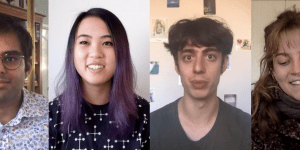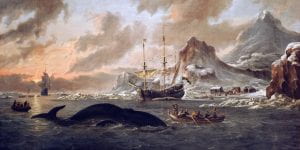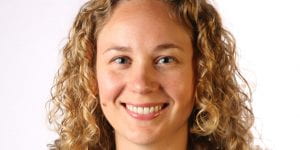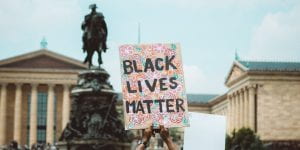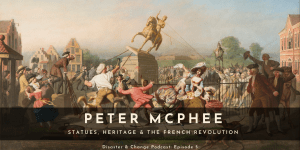Category: Sound & Vision
-
Body-makers and Farthingale-makers in Seventeenth-century London
By 1700 tailors no longer dominated England’s garment marketplace, as stay-makers, mantua-makers and seamstresses began to produce key items of female dress previously made by tailors. The demise of the tailoring monopoly was a complex process that involved many factors. On 3 September, our McKenzie Fellow, Sarah Bendall, presented the weekly Brown Bag talk, which […] -
From HPS to Saving Planet A
Recently, HPS Alumna Dr Zoë Loh featured on the ABC documentary Fight for Planet A in relation to her role as a senior research scientist at CSIRO. In this interview, Zoë spoke with Samara Greenwood about her love for History and Philosophy of Science and how it has contributed not only to her career, but […]blogs.unimelb.edu.au/shaps-research/2020/09/01/from-hps-to-saving-planet-a
-
Students Chat about Philosophy
We are social creatures and the current lockdown isolation is hard on all of us – whether extrovert or introvert. So we thought you might enjoy meeting some of our wonderful students. Philosophy is currently one of the fastest growing majors in the Arts Faculty. These self-made mini videos will give you a glimpse of […]blogs.unimelb.edu.au/shaps-research/2020/08/28/students-chat-about-philosophy
-
The Bishop with 150 Wives
Francis Xavier Gsell is famous for his work among the Tiwi people, from whom he purchased the marriage rights to young women as part of a broad evangelisation strategy. A mythic figure in popular histories of the Northern Territory, Gsell is often remembered as the apocryphal ‘Bishop with 150 Wives’. But Gsell’s complex legacy has […]blogs.unimelb.edu.au/shaps-research/2020/08/17/the-bishop-with-150-wives
-
“Ffor Whalebones to it”: The Baleen Trade and Fashion in Sixteenth-century Europe
During the sixteenth century the bodies of Europe’s elites began to change in size and form as men and women adopted wide starched ruffs and collars, ballooning sleeves, stiffened or bombast upper garments and puffy lower garments. Such a structured silhouette set the tone for centuries of fashion and was the result of changing artistic […]blogs.unimelb.edu.au/shaps-research/2020/08/17/ffor-whalebones-to-it
-
SHAPS Digest (July 2020)
A monthly round-up of media commentary, publications and projects, and other news from across the School community.blogs.unimelb.edu.au/shaps-research/2020/08/10/shaps-digest-july-2020
-
Confronting the History of Race and Empathy in the Classroom: A Conversation with Dr Sarah Walsh
In June 2020, Dr Sarah Walsh joined the History Program as our new Hansen Lecturer in Global History. In this new podcast, in conversation with History PhD candidate Amy Hodgson, Dr Walsh discusses her research, and her approach to teaching. The interview traverses a wide range of topics, including the challenges posed by online teaching, especially when it comes to handling difficult and confronting histories of oppression and violence. What approaches can be used to foster empathy and kindness in the classroom? What methods can researchers working on these topics use in order to take care of their own mental health and wellbeing? And what are some useful starting points for people who want to educate themselves about issues around race and racism? -
SHAPS Digest (June 2020)
A monthly round-up of media commentary, publications and projects, and other news from across the School community.blogs.unimelb.edu.au/shaps-research/2020/07/09/shaps-digest-june-2020
-
Episode 5 in the SHAPS Podcast Series: Professor Peter McPhee
Societies have always used statues and other monuments as ways of recognising power and eminence. In Australia, as in many other places, there is currently public debate over whether some statues should be removed, who should make the decision, and what should be the fate of the statues themselves. Should they be displayed with explanatory plaques, taken away to be preserved in museums or simply removed? Such debates are common in history. In this episode, Professor Peter McPhee surveys the wide range of objects destroyed during the French Revolution – from buildings and statues to books and paintings – but also the remarkable responses of revolutionary governments. It concludes with some reflections about the place of monumental statues and heritage sites in Australia.blogs.unimelb.edu.au/shaps-research/2020/07/06/disaster-change-5
-
National Archaeology Week 2020 Goes Online
Each year in the third week of May, Australia celebrates National Archaeology Week. This year, our postgraduate community took a leading role in taking National Archaeology Week online, coming up with creative ways of promoting archaeology in a time of pandemic-related disruption. Larissa Tittl gives us a run-down on the week’s events and activities. National […]blogs.unimelb.edu.au/shaps-research/2020/06/29/national-archaeology-week-2020-goes-online
Number of posts found: 112


